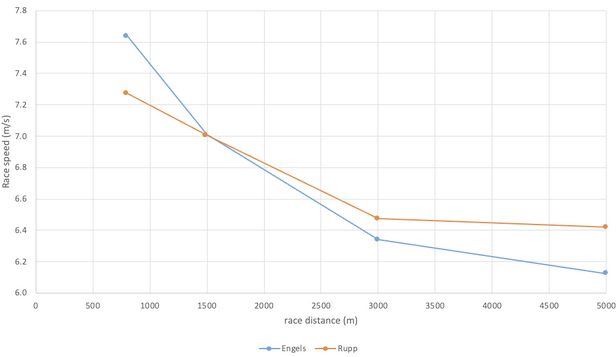How does a knowledge of the energy systems help us understand performance in middle and long-distance events?
Up until now, we have considered the energy systems in isolation, but during a race they operate in a coordinated manner to supply the energy required. As race distance increases, fuel stores deplete and waste products build-up, these can slow the rate of ATP replenishment thereby reducing average race speed. Table 1 shows the energy systems contribution for middle and long-distance races8–10. These figures differ from older figures: importantly, they were determined using measurements recorded throughout simulated races, and show higher aerobic contributions than previously thought.

It is not the race distance however, that determines the energy systems contribution – it is the race duration. A world class male athlete will run 2000m in under 5 minutes – a time many athletes might run for 1500m. In this instance, they would all have similar aerobic:anaerobic contributions.
Table 2 shows the relative contributions from the aerobic and anaerobic systems during exercise lasting between 75s and 4-minutes. Two things to note here: firstly, this only applies to maximal effort over the time period; secondly, that beyond around 75s, activities become predominantly aerobic further, reinforcing the idea that the 800m is predominantly aerobic. The tactical situations in races also impacts upon this. (More on this in the anaerobic speed reserve section).

One way to look at this, is to consider the speed-duration relationship. Figure 3 shows the average speed that is maintained for the world records over Olympic race distances in male and female runners. This relationship, first identified back in the early 1920s, shows the upper limit of human performance. The shape of the graph reflects the energetic contributions to performance. As race distance increases beyond 200m there is a sharp drop off in race speed reflecting the depletion of PC stores and increased reliance on glycolysis. PC stores are almost entirely depleted at the end of a 100m race, but the average speed in the 100 and 200m is similar because the acceleration phase has a bigger contribution in the 100m, thereby reducing average speed.
From around the 800m mark the curve begins to flatten out as the contribution from glycolysis diminishes and the aerobic contribution increases. Beyond 10k, the energy is derived almost exclusively from the aerobic system, reflecting the maximal rate that pyruvate can be processed within the mitochondria. As we shall soon see, this maximum rate at which the mitochondria can produce ATP is extremely important.

Using world records does not really reflect what happens at an individual level because they are set by different people, who have different physiology. Figure 4 shows the speed-duration relationship for a middle (Craig Engels) and long-distance (Galen Rupp) runner. The curves are similar, but specific to each individual and sensitive to training.

That ends the sidetrack into energy systems. As stated earlier, running is a movement pattern and is determined by a complex interplay of numerous factors shown in figure 1.
We now move on to explore each of these determinants of endurance performance.

What is your understanding of energy system development and other factors that may determine endurance performance?
Before knowing where knowledge might take you, it can be useful to know where it has come from. Join Peter Thompson in the two 7 min videos below, as he shares his journey that led him to recognize that Endurance Performance is determined by more than just energy system development alone.
PART 1: BIOENERGETICS
PART 2: Contributions of Energy Systems
You may also find this paper by Peter – Current perspectives of biokinetics in Middle & Long Distance Running – An example of the ‘elastic response’ – an interesting addendum to the above discussions.
